KALLET SHOPPINGTOWN THEATRES - East of Syracuse, NY

Kallet Theatres ran the top two prestige theatres in Syracuse, Kallet Shoppingtown and Kallet Genesee. The original Shoppingtown theatre opened in the Spring of 1957, behind the large shopping center on Erie Blvd East, in DeWitt, NY. Only the marquee was visible from the street side. The cut out of Julie Andrews and Christopher Plummer and the children was from a 24-Sheet (billboard size) poster. During the 77 week run of SOUND OF MUSIC, it had to be replaced three times because the colors faded in the sun.
the Kallet Shoppingtown was the first theatre in Central NY built specifically to run 70mm Todd-AO. When it opened, it was the only Todd-AO equipped theatre between New York City and Buffalo.

The theatre entrance was located at the rear of the shopping center, next to the local ABC TV studio. There was a winding hallway and staircase that led to the theatre from the storefront side. Display cases along the way heralded the current feature, and let you know you were heading in the right direction.
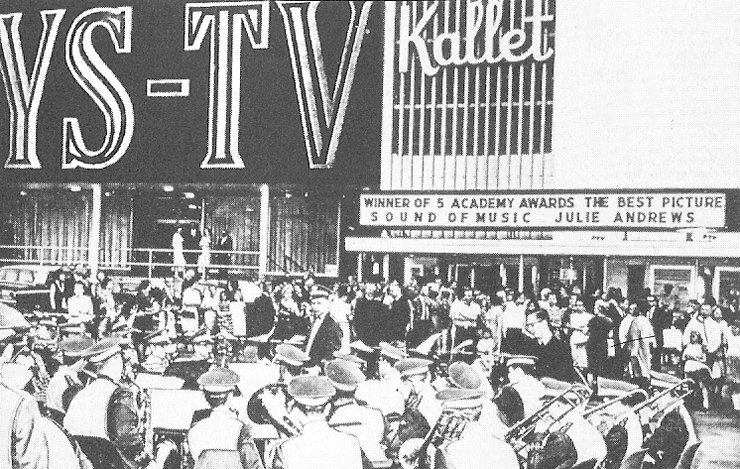
For the Kallet Shoppingtown's opening feature, Rodgers and Hammerstein's OKLAHOMA!, The marquee included the original Todd-AO slogan...

"YOU ARE IN THE SHOW YOU LIKE THE SHOW"
RODGERS & HAMMERSTEIN'S OKLAHOMA IN TODD AO
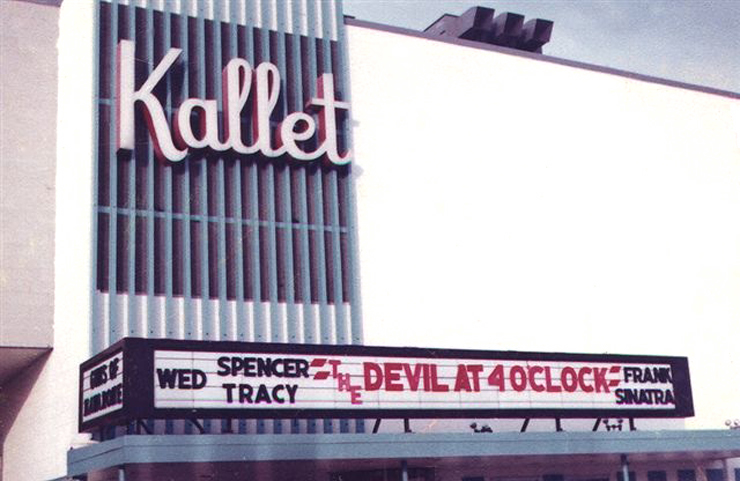
The exterior was of concrete blocks painted white and accented by eight porcelain panels in two rows of harmonizing colors. The Kallet sign was white outlined with red, placed on vertical redwood strips that were painted blue. The circular boxoffice was faced with orange glass tile.

The layout for the theatre was designed to give patrons an interesting and functional environment. The architect's blueprint shows the double circle effect of the lobby and vestibule, along with the locations of the circular boxoffice, circular entrance doors, two concession stands, restrooms and manager's office.
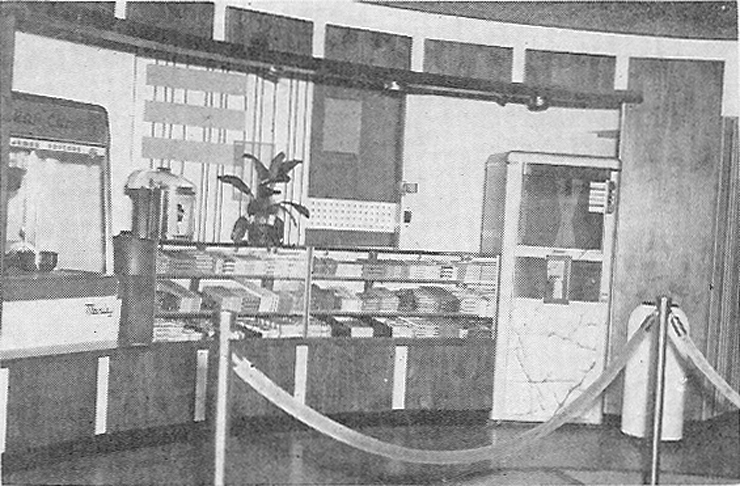
The main concession stand in the circular lobby featured an abstract panel of pegboard, bronze screening and vertical rods on the backbar. Walnut paneling formed the facing of the concession stand, extending from the popcorn popper to the soft drink machine at end of the candy case.
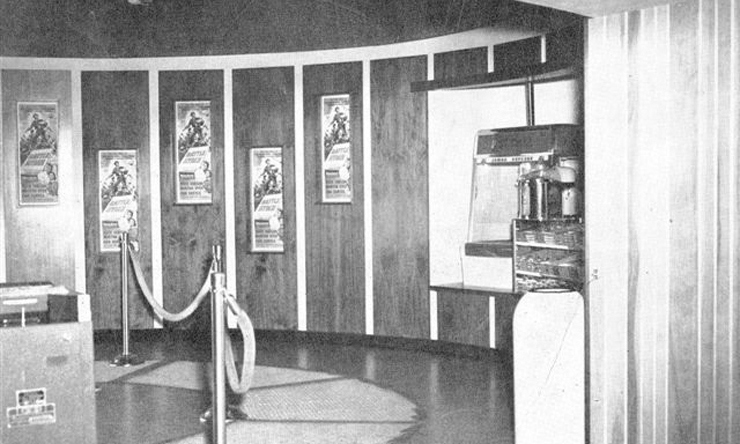
A view of the lobby from the vestibule. The exterior entrance doors were off to the left. Adjacent to the lobby concession stand were walnut panels with displays of coming attractions. The lobby's terrazzo floor was accented with a circle of rubber padding, and the ceiling was black plaster flecked with gold.
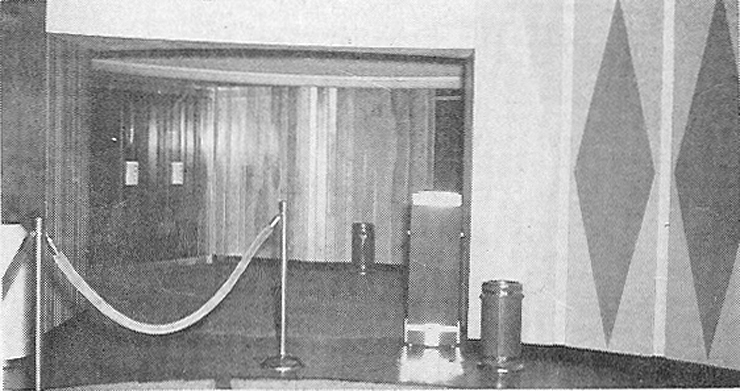
A view from the outer lobby. This wall was decorated with seven tall plastic diamond panels in aquamarine, gray, rust, yellow and white. Two of those panels hid doors to the boxoffice and projection booth. The lighter birch paneling in the circular vestibule contrasted nicely with the warm walnut paneling of the lobby.
Along with doors to the auditorium, the vestibule had a second concession window off to the left. On weekends and busy nights, two people staffed the two concession counters. During the week, one person served both. To the right were the restrooms, water fountains, and the manager's office. This layout ensured that patrons need not go all the way out to the main lobby to buy popcorn or use the facilities.
A panel of formica between the restrooms backed two stainless steel fountains serving chilled water.
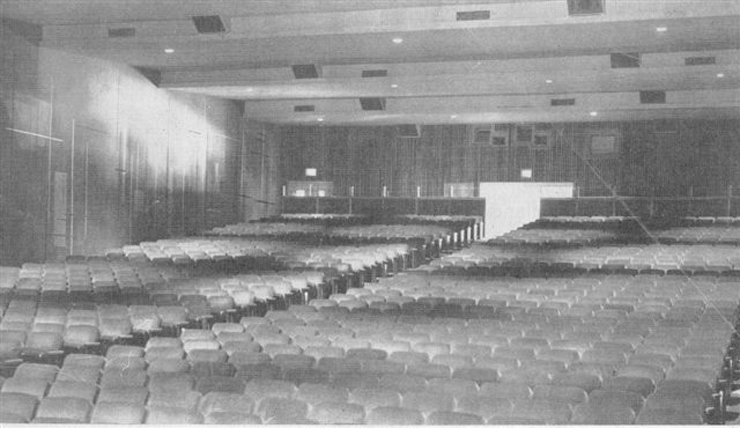
The rear wall of the theatre was covered with two inch natural finish birch strips, spaced three inches apart, backed by fiberglas batts, to absorb sound.
The theatre's decorator, Oscar Glas, of Belgium Art Studios, designed 120x26' abstract murals for the side walls. The minimal pattern of colored rectangles with black and white streaks on a gray background, was called "futuristic" in 1957.
The sloped ceiling, of acoustic mineral tile alternating with plaster, was slanted in steps that concealed the twelve surround speakers and air conditioning ducts from the audience's view. Recessed lighting could be set to various levels.
A steeply sloped floor (which today's building codes no longer allow) was the key to giving every seat an eye level sightline to some part of the screen.
The auditorium held 1,009 seats, divided into two sections, upholstered in gray mohair over four inches of foam rubber. Gray-beige carpet, with metallic strands of silver and gold, went right up to the screen.
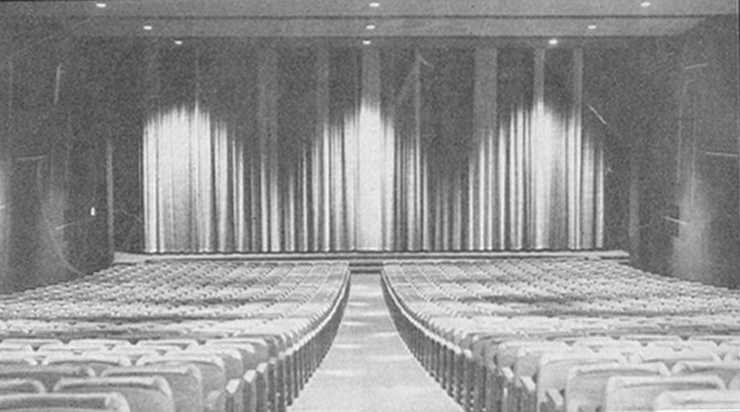
The flexible 23x49' Todd-AO screen was curved by 128 degrees for 70mm Todd-AO (2.20:1) films. For 35mm CinemaScope (2.35:1), the screen was masked down to 21x43.5' and could be less curved. It could be flattened out at 21x38" for regular (1.85:1 or 1.66:1) films.
The seven color velour curtain was striped in two shades of blue, two shades of gray, gold, coral and green. To clear a nearly wall to wall screen, the curtain rode on a track that turned backward along the side walls. On many occasions, the curtain rollers would get stuck behind the bend in the track. The screen would remain exposed (a big no-no in those days) until George Read, Manager of the Kallet Genesee, brought a huge A-ladder across town and climbed up about 25 feet to free the curtain.
The Kallet Shoppingtown was home to many exclusive reserved seat roadshow engagements, including SOUTH PACIFIC, AROUND THE WORLD IN 80 DAYS, BEN-HUR, THE SOUND OF MUSIC, THE SAND PEBBLES, and DOCTOR DOLITTLE. The long-running exclusive engagement of MARY POPPINS immediately preceded the record-breaking 77 week run of THE SOUND OF MUSIC, keeping the Shoppingtown Theatre alive with the sound of Julie Andrews for over two years.
During a huge blizzard in February of 1966, the ABC station nextdoor broadcast part of a news program from the theatre, asking the snowbound Shoppingtown staff what they did to pass the time... What would you do if you were stuck in a handsome theatre with a 70mm print of THE SOUND OF MUSIC and plenty of fresh popcorn? Well... the picture had been playing for nearly a year by then.

This TODD-AO projector at Kallet Shoppingtown is running an anamorphic 70mm print of BEN-HUR.
The Shoppingtown theatre had a proud but short (11 year) life before being replaced in 1968 by the first new twin theatre built in upstate NY. The original theatre was blocked off by a big new department store. It sat vacant for a while, was later used for offices, and eventually demolished for extra stores. The Todd-AO 70mm projectors were moved to Theatre II in the new location.

Kallet Shoppingtown I & II, a new separate building just a few feet across from the far edge of the shopping center, opened in December 1968 with exclusive roadshow premieres of STAR! and FUNNY GiRL. The building exterior was a medium-light blue in the front, with three non-marquees overhanging two sets of doors and the six-window boxoffice. Exterior side walls were an off white. Local ordinances severely restricted signage, so Shoppingtown I & II had only a tiny two line lighted reader board on the street-side wall.
Feature displays were usually limited to small custom signs, in the windows above the boxoffice, and just above the entry to each theatre in the lobby. For the roadshow engagements of HELLO, DOLLY! and GOODBYE, MR. CHIPS, the movies' logos were cut out in large white letters and attached to the front overhangs on each side of the boxoffice. Later on, when the logo for WOODSTOCK was spelled out in huge orange letters along the length of the street side wall, they only hung for one day before the town ordered that they be removed.
The auditoriums of the new theatre were similar in design to the original Shoppingtown, (sloped ceiling and floors, two seating sections with a center aisle, vertical wood strips along the back wall). The two identical auditoriums, separated by an airspace to prevent sound leakage, shared a common outer lobby gallery that ran nearly the full width of the building. At the center of the lobby, the rear wall had two archways, about six feet apart. Each theatre had its own inner lobby and restrooms, and shared half of the two-sided concession stand that served both theatres. From each inner lobby, you could look across the concession stand into the lobby on the other side.
The sleek, modern auditoriums sat about 800 each, with side walls in a pastel neutral color that were divided into panels. Each wall panel was a shade darker than the one before it. The effect was that the walls were darker near the screen than at the back. Black and white patterned curtains were framed by a simple black proscenium, which allowed enough room for the curtains to clear the big screen without needing the track to bend backwards. (this meant the rollers didn't get stuck as they had in the original house) The theatres had "curtain warmer" lights, as well as full range dimmers. Light touches of color were the thick orange railings that ran the length of each wall, and the carpet in a "play on reds" pattern (shades of blue, violet, purple and red) that went right up to the screen.
After pitting STAR! Julie Andrews up against FUNNY GIRL Barbra Streisand, The Shoppingtown I & II featured roadshow engagements of HELLO, DOLLY!, GOODBYE, MR. CHIPS, and SWEET CHARITY, plus special showcase engagements of AIRPORT, WOODSTOCK, EARTHQUAKE (in Sensurround!) THE ANDROMEDA STRAIN, and TOMMY (in the gimmicky ear blasting "quintaphonic sound" - advertised as an innovation in spite of the fact that 70mm movies already had six channel sound since the fifties.) An era of showmanship ended soon after the original THAT'S ENTERTAINMENT! brought a nice return to musicals at Shoppingtown Theatre I in 1974.
When Kallet sold the Shoppingtown and Genesee theatres to CinemaNational in 1974, the quality of both theatres began to spiral downward. The theatres changed hands several times and eventually Shoppingtown I & II were each split in half, front and back. The individual stores of Shoppingtown eventually transformed into an indoor mall. This second Shoppingtown theatre building was later abandoned, replaced by a bland tenplex inside the new mall, then demolished.
Along with nearly every other sixties era single screen theatre in the greater Syracuse area, The original Shoppingtown Theatre, and the subsequent twin are both long gone, but for a youngster who was used to an older theatre in a smaller town 40 miles away, they left a strong impression that will last a lifetime.
Text compiled, and written © 2007 by TJ Edwards Photos courtesy of, and © by, George E. Read
Across Town in Syracuse:
A talented manager brought real Showmanship to the KALLET GENESEE THEATRE.
Downtown Syracuse: Schine's ECKEL CINERAMA THEATRE